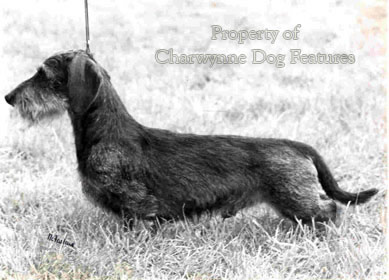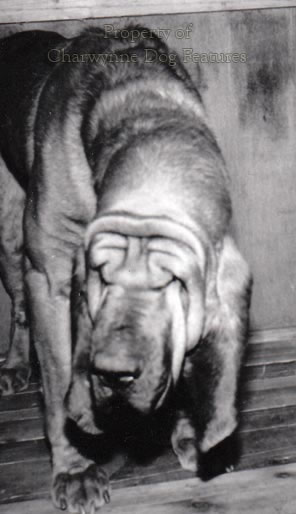61 SHAMED INTO RESHAPING OUR OWN BREEDS
SHAMED INTO RESHAPING OUR OWN BREEDS
by David Hancock

 Twenty different European governments have signed up to the European Convention on Pet Animals, ETS 125, which aims, amongst other things, to reduce the suffering of dogs from exaggerations inflicted by man. These exaggerations cover such aspects as overlong backs, excessively short legs, shortness of skull, excessively long ears, markedly folded skin, the pursuit of great size and weight to the detriment of the dog's well-being, abnormal size and form of eyes, etc. It lists breeds where it is considered that suffering exists: Dachshunds, Basset Hounds, Bulldogs, Pekingese, Cocker Spaniels, Cavaliers, Pugs, Chinese Shar Pei, Bloodhounds, Chow Chows and many others. Britain has not signed up, following lobbying to DEFRA by the KC, which believes that the best way to succeed lies in the steady revision of some breed descriptions or standards. Is this 'interference from Brussels' as some knee-jerk responders have claimed, or is opposition here itself merely the manifestation of wallet-led self-interest?
Twenty different European governments have signed up to the European Convention on Pet Animals, ETS 125, which aims, amongst other things, to reduce the suffering of dogs from exaggerations inflicted by man. These exaggerations cover such aspects as overlong backs, excessively short legs, shortness of skull, excessively long ears, markedly folded skin, the pursuit of great size and weight to the detriment of the dog's well-being, abnormal size and form of eyes, etc. It lists breeds where it is considered that suffering exists: Dachshunds, Basset Hounds, Bulldogs, Pekingese, Cocker Spaniels, Cavaliers, Pugs, Chinese Shar Pei, Bloodhounds, Chow Chows and many others. Britain has not signed up, following lobbying to DEFRA by the KC, which believes that the best way to succeed lies in the steady revision of some breed descriptions or standards. Is this 'interference from Brussels' as some knee-jerk responders have claimed, or is opposition here itself merely the manifestation of wallet-led self-interest?
Many of our breed standards were drafted when the breed was emerging and a word picture was needed in order to get fanciers to breed to type. But for a breed which has been recognised for fifty years or more, there are other considerations too. Has the breed been bred to suit the fanciers rather than the dog? Are we breeding dogs to look pretty or with their health and well-being at the front of our minds? On mainland Europe we are renowned as dog-exaggerators ahead of dog-lovers. Their breeding procedures are tighter than ours, with health clearances being necessary before breeding can be attempted. It will never be enough to claim that if we adhere to the breed's word picture then all flaws will disappear.

We really must be realistic too about the impact of word pictures, both on those misguided souls seeking to exaggerate breed features, and especially, on the breeds of dog which have been physically handicapped by our knowing pursuit of excess in their anatomical form. Why do Pugs and Bulldogs suffer from respiratory problems? Why do Bassets and Dachshunds have spinal problems? Can a 20-stone Mastiff lead a long healthy life? Pugs and Bulldogs don't have muzzles; Bassets and Dachshunds have extremely long backs; the Mastiff is favoured in massive size, its breed standard demands a massive body, with size greatly desired. If a lack of a muzzle facilitates respiratory difficulties, if excessively long backs produce spinal problems, and unwise great size produces unsoundness, does the wording of the breed standard alone not encourage exaggeration?
The propaganda that 'Brussels is threatening our native breeds' is unworthy and undeserved. An alternative headline could be 'Can Brussels make us breed healthier dogs?' Exaggerated breeds have changed noticeably from the prototypal specimens in those breeds. An accurate headline on this subject could read 'Type in native breeds to be restored'; the shame is that it is taking an edict from mainland Europe to achieve it. We have not been faithful custodians of far too many of our own breeds. Our national body in the world of pedigree dogs has not provided watchful responsible stewardship or inspired guardianship. Many of our native breeds have been abandoned to the exaggerators. 
To expect every harmful exaggeration in breeds of pedigree dog to be rectified by an exhortation to show ring judges to regard faults in exact proportion to their degree and effect upon the health and welfare of the dog, is to enter dreamland. But that is how the KC is planning to remedy the physical handicaps placed upon many breeds, under their aegis, and it is their sole measure. This is worse than dreamland, it is head in sand territory. It takes enormous impudence for the KC to say to DEFRA, 'stand back, we can single-handedly put this right, oh, and by the way, we caused the problem in the first place!'
If you wish to rectify the absence of a muzzle in a Bulldog, and therefore the imposition of dentition and respiratory problems, a considerable loss of scenting ability, a rotting fold above the nose and parturition difficulties, you have to breed for a different skull. The only way to do that is to outcross to another breed or to an improved type of Bulldog. It is the only option. This, rather than altering a traditional British breed, could mean restoring it to its classic form. The Regency Bulldog was far healthier than the Bulldog of Victorian times, when the short face was intentionally bred for. This harmful exaggeration was sought by breed-fanciers, condoned by breed clubs and permitted by a supine kennel club.
Another admirable British breed, the Mastiff, was re-created by Victorian fanciers, mainly from alien stock, to resemble not the time-honoured strapping British dog, but an ungainly Alpine Mastiff, quite unlike our breed of previous centuries. You cannot restore the latter by imploring judges to penalise excessive weight and needless bulk. You have to acknowledge how the problem was created at all. You have to face up to what is actually required to breed out giant faults in a breed never intended to be a giant breed by our ancestors.
Unless the reality of this whole business is truly faced, we could as a dog-loving nation, be utterly humiliated through the mainland European nations reshaping our native breeds for us. Having witnessed a British Bulldog being carried unconscious from a world dog show ring in Brussels a decade ago, from respiratory failings caused by heartless breeders and an equally heartless Kennel Club, I cannot wait to see ETS 125 ratified by our government. We have totally failed to breed some of our breeds with their best interests in mind. I really don't care about breeders' interests. Anyone breeding a subject creature to a harmful design and with built-in handicaps does not deserve support, especially from a government department.